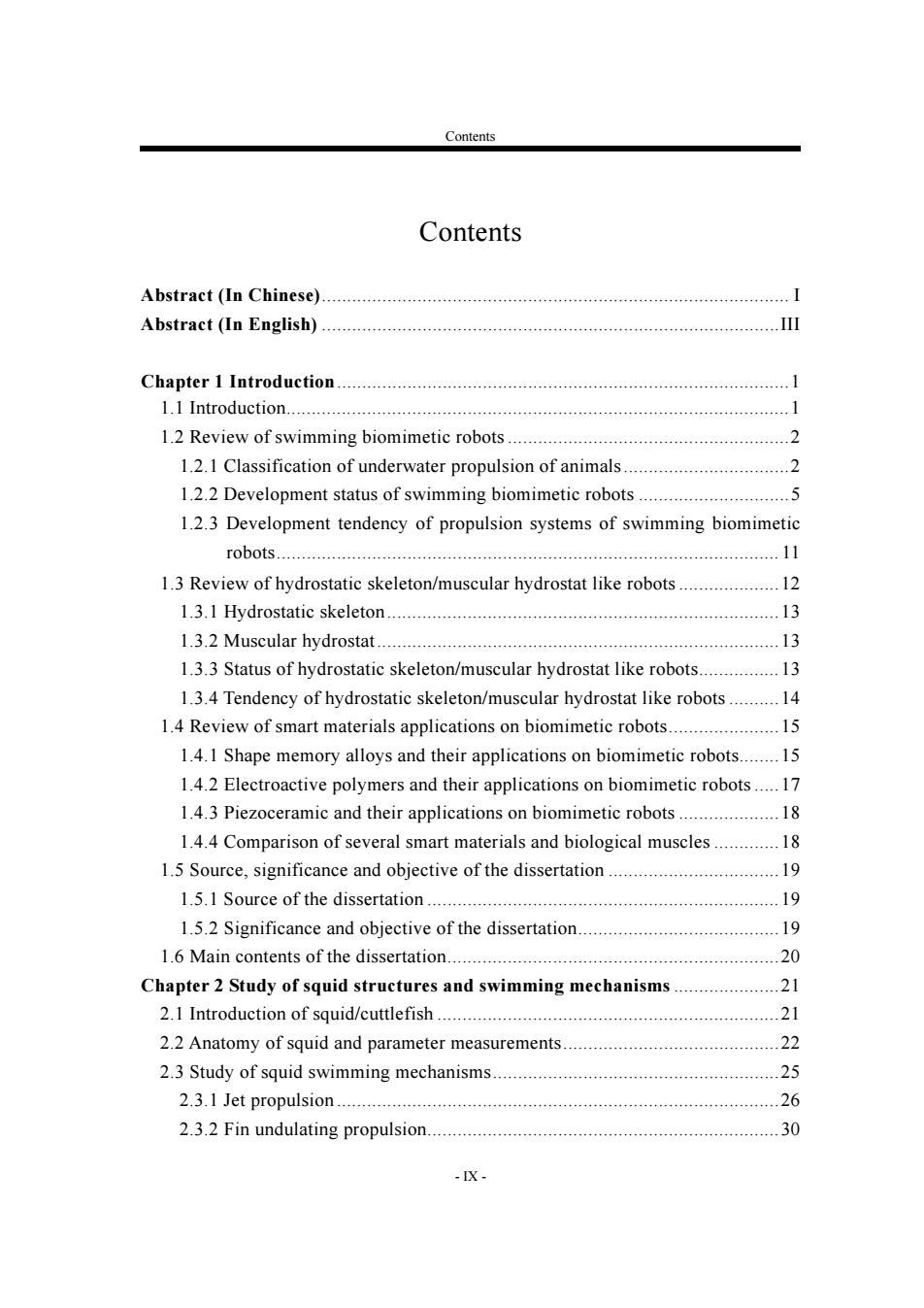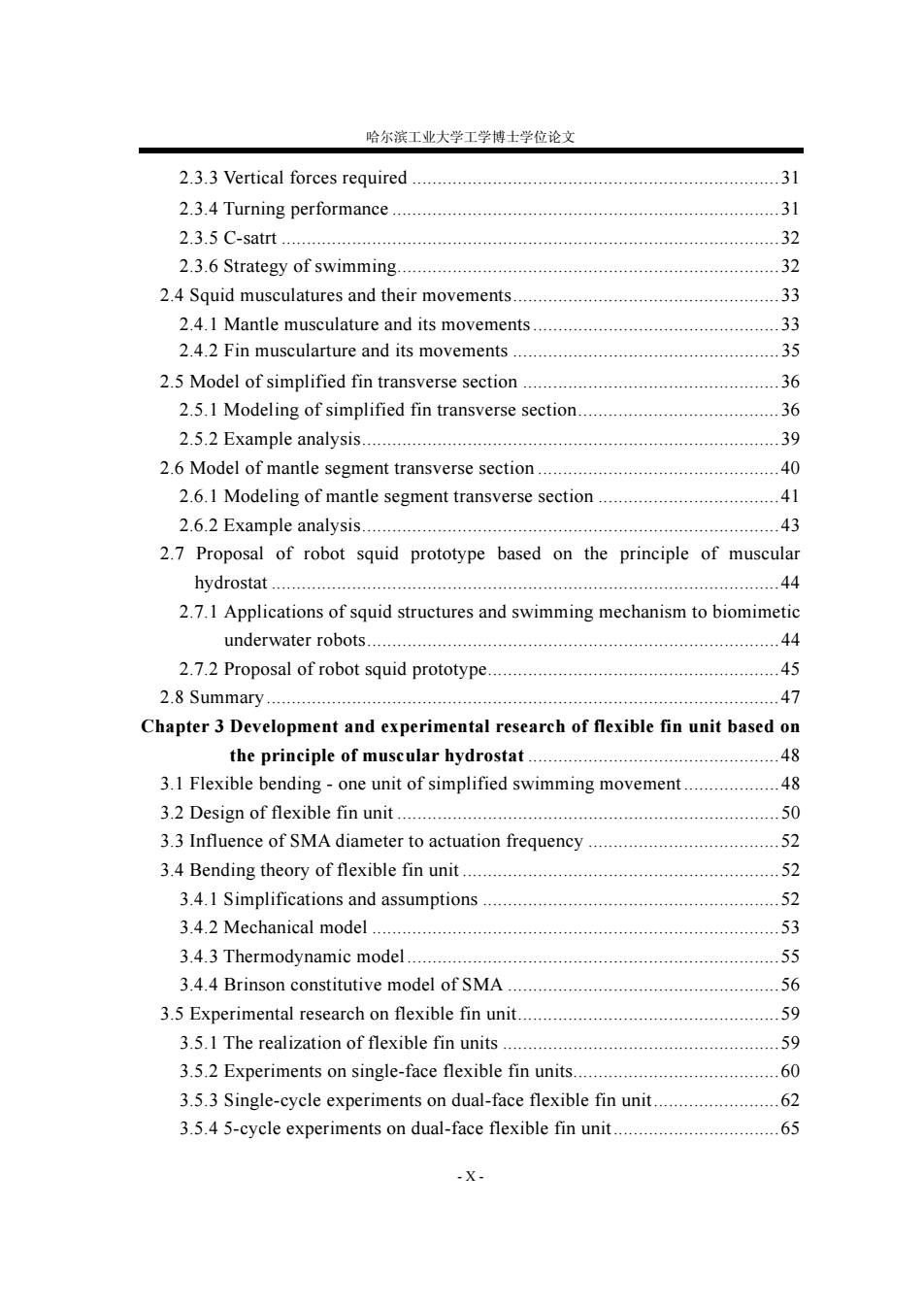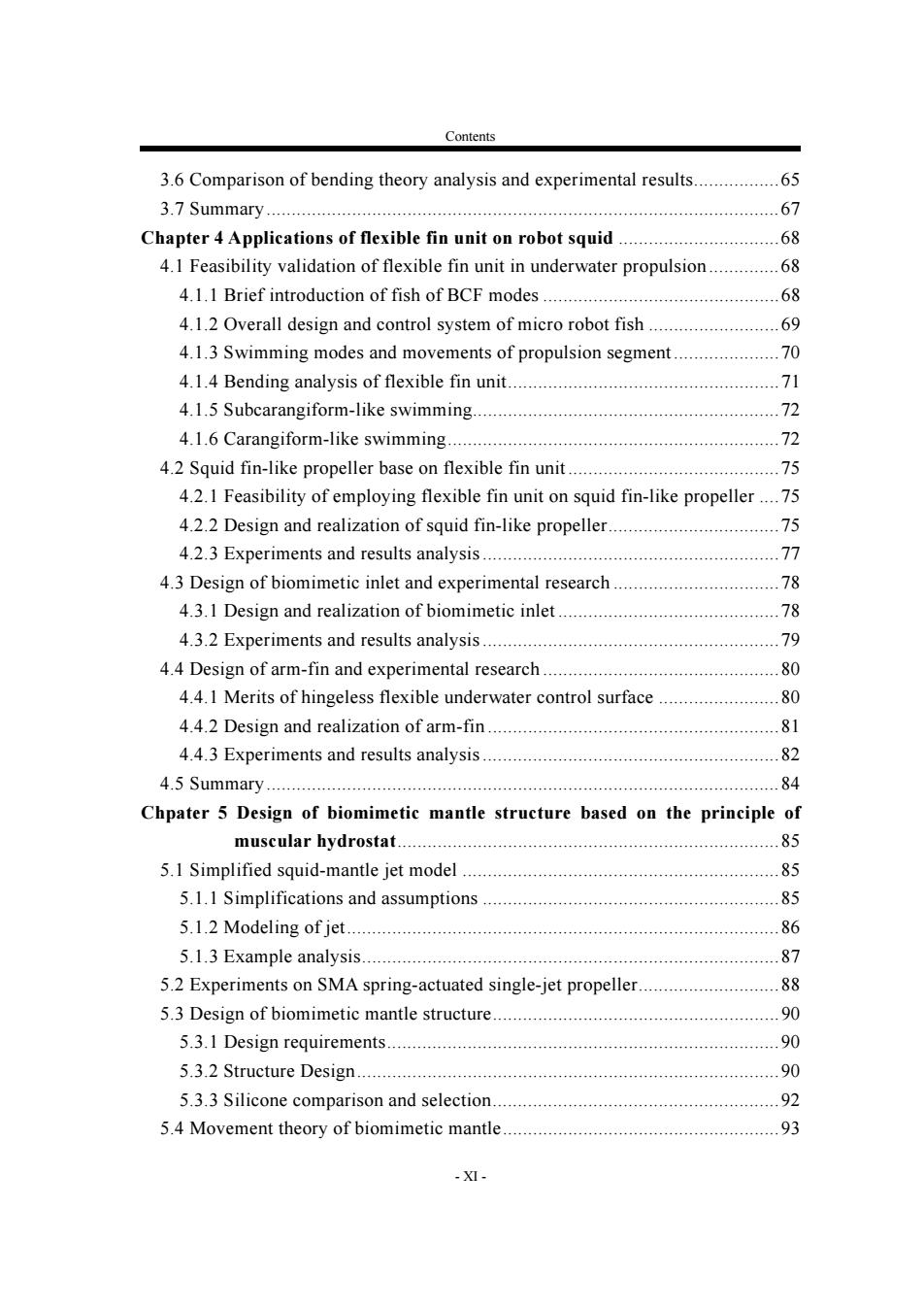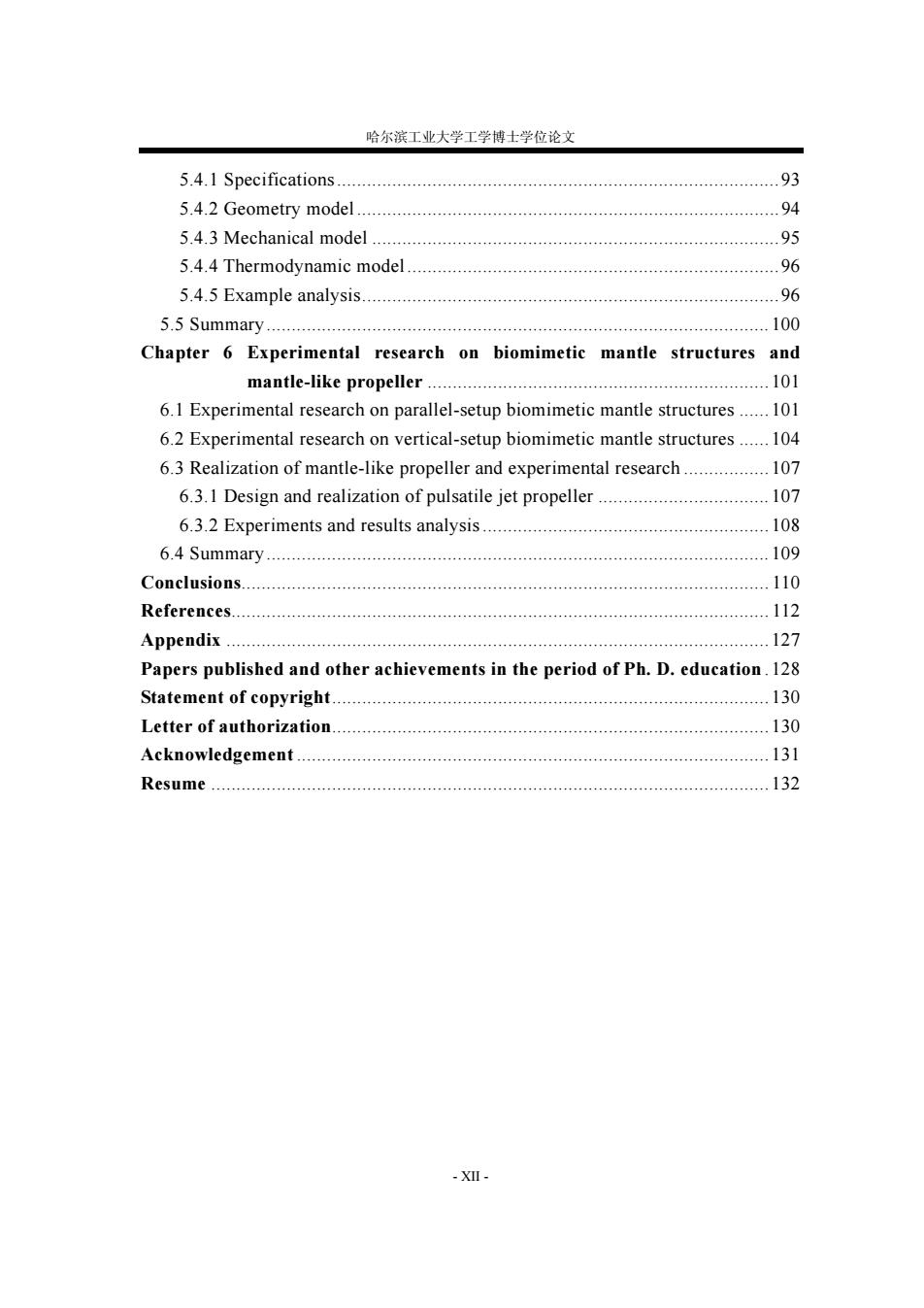
Contents Contents Abstract(In Chinese) Abstract (In English).III Chapter I Introduction.... 1.2 Review of swimming biomimetic robots........................ 2 1.2.1 Classification of underwater propulsion of animals....................2 1.2.2 Development status of swimming biomimetic robots 1.2.3 Development tendency of propulsion systems of swimming biomimetic robots.......... .11 1.3 Review of hydrostatic skeleton/muscular hydrostat like robots 12 1.3.I Hydrostatic skeleton.. 13 1.3.2 Muscular hydrostat...... 13 1.3.3 Status of hydrostatic skeleton/muscular hydrostat like robots...............3 1.3.4 Tendency of hydrostatic skeleton/muscular hydrostat like robots.........14 1.4 Review of smart materials applications on biomimetic robots .15 1.4.1 Shape memory alloys and their applications on biomimetic robots........15 1.4.2 Electroactive polymers and their applications on biomimetic robots.....17 1.4.3 Piezoceramic and their applications on biomimetic robots 18 1.4.4 Comparison of several smart materials and biological muscles............18 1.5 Source,significance and objective of the dissertation..... 19 1.5.I Source of the dissertation. 19 1.5.2 Significance and objective of the dissertation................. 19 1.6 Main contents of the dissertation...... 20 Chapter 2 Study of squid structures and swimming mechanisms 21 2.1 Introduction of squid/cuttlefish21 2.2 Anatomy of squid and parameter measurements. 22 2.3 Study of squid swimming mechanisms. 25 2.3.1 Jet propulsion… 26 2.3.2 Fin undulating propulsion 30 -X-
Contents - IX - Contents Abstract (In Chinese)............................................................................................. I Abstract (In English) ...........................................................................................III Chapter 1 Introduction..........................................................................................1 1.1 Introduction....................................................................................................1 1.2 Review of swimming biomimetic robots ........................................................2 1.2.1 Classification of underwater propulsion of animals.................................2 1.2.2 Development status of swimming biomimetic robots ..............................5 1.2.3 Development tendency of propulsion systems of swimming biomimetic robots.................................................................................................... 11 1.3 Review of hydrostatic skeleton/muscular hydrostat like robots ....................12 1.3.1 Hydrostatic skeleton..............................................................................13 1.3.2 Muscular hydrostat................................................................................13 1.3.3 Status of hydrostatic skeleton/muscular hydrostat like robots................13 1.3.4 Tendency of hydrostatic skeleton/muscular hydrostat like robots ..........14 1.4 Review of smart materials applications on biomimetic robots......................15 1.4.1 Shape memory alloys and their applications on biomimetic robots........15 1.4.2 Electroactive polymers and their applications on biomimetic robots .....17 1.4.3 Piezoceramic and their applications on biomimetic robots ....................18 1.4.4 Comparison of several smart materials and biological muscles .............18 1.5 Source, significance and objective of the dissertation ..................................19 1.5.1 Source of the dissertation ......................................................................19 1.5.2 Significance and objective of the dissertation........................................19 1.6 Main contents of the dissertation..................................................................20 Chapter 2 Study of squid structures and swimming mechanisms .....................21 2.1 Introduction of squid/cuttlefish ....................................................................21 2.2 Anatomy of squid and parameter measurements...........................................22 2.3 Study of squid swimming mechanisms.........................................................25 2.3.1 Jet propulsion ........................................................................................26 2.3.2 Fin undulating propulsion......................................................................30

哈尔滨工业大学工学博士学位论文 2.3.3 Vertical forces required 31 2.3.4 Turning performance...... 31 2.3.5 C-satrt 32 2.3.6 Strategy of swimming. 32 2.4 Squid musculatures and their movements 33 2.4.1 Mantle musculature and its movements..33 2.4.2 Fin muscularture and its movements 35 2.5 Model of simplified fin transverse section..............................36 2.5.1 Modeling of simplified fin transverse section.....................36 2.5.2 Example analysis. 39 2.6 Model of mantle segment transverse section4 2.6.1 Modeling of mantle segment transverse section.4. 2.6.2 Example analysis.............. .43 2.7 Proposal of robot squid prototype based on the principle of muscular hydrostat.… ..44 2.7.1 Applications of squid structures and swimming mechanism to biomimetic underwater robots.... ....44 2.7.2 Proposal of robot squid prototype........ ..45 2.8 Summary .47 Chapter 3 Development and experimental research of flexible fin unit based on the principle of muscular hydrostat....... 48 3.1 Flexible bending-one unit of simplified swimming movement 48 3.2 Design of flexible fin unit................ 50 3.3 Influence of SMA diameter to actuation frequency...................................5.2 3.4 Bending theory of flexible fin unit 52 3.4.1 Simplifications and assumptions.. 52 3.4.2 Mechanical model 53 3.4.3 Thermodynamic model.55 3.4.4 Brinson constitutive model of SMA 56 3.5 Experimental research on flexible fin unit.................. 59 3.5.1 The realization of flexible fin units 59 3.5.2 Experiments on single-face flexible fin units....................... 60 3.5.3 Single-cycle experiments on dual-face flexible fin unit..62 3.5.4 5-cycle experiments on dual-face flexible fin unit................65 -X-
哈尔滨工业大学工学博士学位论文 - X - 2.3.3 Vertical forces required .........................................................................31 2.3.4 Turning performance .............................................................................31 2.3.5 C-satrt ...................................................................................................32 2.3.6 Strategy of swimming............................................................................32 2.4 Squid musculatures and their movements.....................................................33 2.4.1 Mantle musculature and its movements .................................................33 2.4.2 Fin muscularture and its movements .....................................................35 2.5 Model of simplified fin transverse section ...................................................36 2.5.1 Modeling of simplified fin transverse section........................................36 2.5.2 Example analysis...................................................................................39 2.6 Model of mantle segment transverse section ................................................40 2.6.1 Modeling of mantle segment transverse section ....................................41 2.6.2 Example analysis...................................................................................43 2.7 Proposal of robot squid prototype based on the principle of muscular hydrostat .....................................................................................................44 2.7.1 Applications of squid structures and swimming mechanism to biomimetic underwater robots..................................................................................44 2.7.2 Proposal of robot squid prototype..........................................................45 2.8 Summary......................................................................................................47 Chapter 3 Development and experimental research of flexible fin unit based on the principle of muscular hydrostat ..................................................48 3.1 Flexible bending - one unit of simplified swimming movement ...................48 3.2 Design of flexible fin unit ............................................................................50 3.3 Influence of SMA diameter to actuation frequency ......................................52 3.4 Bending theory of flexible fin unit ...............................................................52 3.4.1 Simplifications and assumptions ...........................................................52 3.4.2 Mechanical model .................................................................................53 3.4.3 Thermodynamic model ..........................................................................55 3.4.4 Brinson constitutive model of SMA ......................................................56 3.5 Experimental research on flexible fin unit....................................................59 3.5.1 The realization of flexible fin units .......................................................59 3.5.2 Experiments on single-face flexible fin units.........................................60 3.5.3 Single-cycle experiments on dual-face flexible fin unit.........................62 3.5.4 5-cycle experiments on dual-face flexible fin unit.................................65

Contents 3.6 Comparison of bending theory analysis and experimental results.................65 3.7 Summary 67 Chapter 4 Applications of flexible fin unit on robot squid 68 4.1 Feasibility validation of flexible fin unit in underwater propulsion 68 4.1.1 Brief introduction of fish of BCF modes......................... 68 4.1.2 Overall design and control system of micro robot fish....................69 4.1.3 Swimming modes and movements of propulsion segment 70 4.1.4 Bending analysis of flexible fin unit................................. 之 4.1.5 Subcarangiform-like swimming....... 72 4.1.6 Carangiform-like swimming. 72 4.2 Squid fin-like propeller base on flexible fin unit....................... 75 4.2.1 Feasibility of employing flexible fin unit on squid fin-like propeller....75 4.2.2 Design and realization of squid fin-like propeller.............. .75 4.2.3 Experiments and results analysis................ 77 4.3 Design of biomimetic inlet and experimental research 78 4.3.1 Design and realization of biomimetic inlet.................... 78 4.3.2 Experiments and results analysis........... .79 4.4 Design of arm-fin and experimental research........... 80 4.4.1 Merits of hingeless flexible underwater control surface...80 4.4.2 Design and realization of arm-fin.................... 81 4.4.3 Experiments and results analysis.82 4.5 Summary.… 84 Chpater 5 Design of biomimetic mantle structure based on the principle of muscular hydrostat.................................... 85 5.1 Simplified squid-mantle jet model 85 5.1.1 Simplifications and assumptions.... 85 5.1.2 Modeling of jet.. 86 5.1.3 Example analysis....... .87 5.2 Experiments on SMA spring-actuated single-jet propeller 88 5.3 Design of biomimetic mantle structure.9 5.3.I Design requirements. 90 5.3.2 Structure Design.......... 90 5.3.3 Silicone comparison and selection.... .92 5.4 Movement theory of biomimetic mantle...93 -XⅪ-
Contents - XI - 3.6 Comparison of bending theory analysis and experimental results.................65 3.7 Summary......................................................................................................67 Chapter 4 Applications of flexible fin unit on robot squid ................................68 4.1 Feasibility validation of flexible fin unit in underwater propulsion ..............68 4.1.1 Brief introduction of fish of BCF modes ...............................................68 4.1.2 Overall design and control system of micro robot fish ..........................69 4.1.3 Swimming modes and movements of propulsion segment .....................70 4.1.4 Bending analysis of flexible fin unit......................................................71 4.1.5 Subcarangiform-like swimming.............................................................72 4.1.6 Carangiform-like swimming..................................................................72 4.2 Squid fin-like propeller base on flexible fin unit ..........................................75 4.2.1 Feasibility of employing flexible fin unit on squid fin-like propeller ....75 4.2.2 Design and realization of squid fin-like propeller..................................75 4.2.3 Experiments and results analysis ...........................................................77 4.3 Design of biomimetic inlet and experimental research .................................78 4.3.1 Design and realization of biomimetic inlet ............................................78 4.3.2 Experiments and results analysis ...........................................................79 4.4 Design of arm-fin and experimental research ...............................................80 4.4.1 Merits of hingeless flexible underwater control surface ........................80 4.4.2 Design and realization of arm-fin ..........................................................81 4.4.3 Experiments and results analysis ...........................................................82 4.5 Summary......................................................................................................84 Chpater 5 Design of biomimetic mantle structure based on the principle of muscular hydrostat............................................................................85 5.1 Simplified squid-mantle jet model ...............................................................85 5.1.1 Simplifications and assumptions ...........................................................85 5.1.2 Modeling of jet......................................................................................86 5.1.3 Example analysis...................................................................................87 5.2 Experiments on SMA spring-actuated single-jet propeller............................88 5.3 Design of biomimetic mantle structure.........................................................90 5.3.1 Design requirements..............................................................................90 5.3.2 Structure Design....................................................................................90 5.3.3 Silicone comparison and selection.........................................................92 5.4 Movement theory of biomimetic mantle.......................................................93

哈尔滨工业大学工学博士学位论文 5.4.1 Specifications............. .93 5.4.2Ge0 metry m0del........94 5.4.3 Mechanical model 95 5.4.4 Thermodynamic model .96 5.4.5 Example analysis. .96 5.5 Summary.… 100 Chapter 6 Experimental research on biomimetic mantle structures and mantle-like propeller..01 6.1 Experimental research on parallel-setup biomimetic mantle structures......101 6.2 Experimental research on vertical-setup biomimetic mantle structures......104 6.3 Realization of mantle-like propeller and experimental research107 6.3.1 Design and realization of pulsatile jet propeller 107 6.3.2 Experiments and results analysis..... 。。。。 108 6.4 Summary..… 109 C0 nclusions.… 110 112 eferences.,,+4444444.∠ Appendix… 127 Papers published and other achievements in the period of Ph.D.education.128 Statement of copyright............. 130 Letter of authorization.. 130 Acknowledgement...... 131 Resume 132 -XⅫ
哈尔滨工业大学工学博士学位论文 - XII - 5.4.1 Specifications........................................................................................93 5.4.2 Geometry model....................................................................................94 5.4.3 Mechanical model .................................................................................95 5.4.4 Thermodynamic model ..........................................................................96 5.4.5 Example analysis...................................................................................96 5.5 Summary....................................................................................................100 Chapter 6 Experimental research on biomimetic mantle structures and mantle-like propeller ....................................................................101 6.1 Experimental research on parallel-setup biomimetic mantle structures ......101 6.2 Experimental research on vertical-setup biomimetic mantle structures ......104 6.3 Realization of mantle-like propeller and experimental research .................107 6.3.1 Design and realization of pulsatile jet propeller ..................................107 6.3.2 Experiments and results analysis .........................................................108 6.4 Summary....................................................................................................109 Conclusions......................................................................................................... 110 References........................................................................................................... 112 Appendix ............................................................................................................127 Papers published and other achievements in the period of Ph. D. education .128 Statement of copyright.......................................................................................130 Letter of authorization.......................................................................................130 Acknowledgement ..............................................................................................131 Resume ...............................................................................................................132

第1章绪论 第1章绪论 1.1引言 正如“上九天揽月”一样,“下五洋捉鳖”也一直是人类千百年来的美好 愿望。人类于20世纪中叶进入了浩瀚的太空,进行了史无前例的探索。然而 人类对于占地球表面积71%的海洋,尤其是深海的认识和开发却进展缓慢, 其重要原因,就是探索设备的缺乏及其能力的限制。 在地球资源日益匮乏的21世纪,开发海洋资源日益凸显战略意义。水下 机器人(Unmanned underwater vehicle,UUV)是人类探索、开发和保护海洋资 源的重要工具,它在探索海底地形,检修人造水下物体,保护领海及对国际海 底区域资源进行“圈地”等方面发挥着至关重要的作用。水下机器人可分为有 缆遥控水下机器人(Remotely operated vehicle,ROV)和无缆自治水下机器人 (Autonomous underwater vehicle,AUV)。多数水下机器人采用螺旋桨推进, 为与后文仿生水下机器人区分,本文称这种水下机器人为传统水下机器人。依 靠高性能的耐压壳,ROV依靠缆线已经能够潜到11000米的最深海底,AUV 也能潜到6000米的深度。但传统水下机器人一般采用整体耐压壳或开放式框 架结构,结构复杂,动作不灵活,噪音大,螺旋桨推进效率低(小型螺旋桨一 般低于40%叮且易被海草、渔网等缠绕,其旋转的桨叶还会危害水下生物。 近年来,针对传统水下机器人的缺点,出现了模仿动物运动的仿生水下机 器人,如模拟高流体推进效率的鱼(可高于80%的机器鱼、模拟龙虾的机器 龙虾4等。电动机由于产品种类多、技术成熟、配套产品多、效率高等优点, 是仿生水下机器人的首选致动器,科研人员还尝试了气动、液压致动器,以及 智能材料(Smart material)致动器。智能材料是指具有感知环境(包括内环境和外 环境)刺激,并对之进行分析、处理、判断,从而通过某些方式进行适度响应 的智能特征的材料,如形状记忆合金(Shape memory alloy,SMA)、电流驱动 聚合物(Electroactive polymer,EAP)、压电陶瓷(Piezo ceramic)等。仿生水下机 器人多采用关节式硬结构,而游动动物大都具有柔性的身体,能进行光顺、低 频的柔性动作,有利于提高游动效率、降低噪音、缓解冲击和减小艉迹。 仿生水下机器人研究尚处于起步阶段,功能较少,潜深一般只有数米。海 洋中每下潜10m就增加1个大气压,这就要求有大潜深需求的水下机器人具 -1-
第 1 章 绪论 - 1 - 第1章 绪论 1.1 引言 正如“上九天揽月”一样,“下五洋捉鳖”也一直是人类千百年来的美好 愿望。人类于 20 世纪中叶进入了浩瀚的太空,进行了史无前例的探索。然而 人类对于占地球表面积 71%的海洋,尤其是深海的认识和开发却进展缓慢, 其重要原因,就是探索设备的缺乏及其能力的限制。 在地球资源日益匮乏的 21 世纪,开发海洋资源日益凸显战略意义。水下 机器人(Unmanned underwater vehicle,UUV)是人类探索、开发和保护海洋资 源的重要工具,它在探索海底地形,检修人造水下物体,保护领海及对国际海 底区域资源进行“圈地”等方面发挥着至关重要的作用。水下机器人可分为有 缆遥控水下机器人(Remotely operated vehicle,ROV)和无缆自治水下机器人 (Autonomous underwater vehicle,AUV)[1]。多数水下机器人采用螺旋桨推进, 为与后文仿生水下机器人区分,本文称这种水下机器人为传统水下机器人。依 靠高性能的耐压壳,ROV 依靠缆线已经能够潜到 11000 米的最深海底,AUV 也能潜到 6000 米的深度。但传统水下机器人一般采用整体耐压壳或开放式框 架结构,结构复杂,动作不灵活,噪音大,螺旋桨推进效率低(小型螺旋桨一 般低于 40%[2])且易被海草、渔网等缠绕,其旋转的桨叶还会危害水下生物。 近年来,针对传统水下机器人的缺点,出现了模仿动物运动的仿生水下机 器人,如模拟高流体推进效率的鱼(可高于 80%[3])的机器鱼、模拟龙虾的机器 龙虾[4]等。电动机由于产品种类多、技术成熟、配套产品多、效率高等优点, 是仿生水下机器人的首选致动器,科研人员还尝试了气动、液压致动器,以及 智能材料(Smart material)致动器。智能材料是指具有感知环境(包括内环境和外 环境)刺激,并对之进行分析、处理、判断,从而通过某些方式进行适度响应 的智能特征的材料,如形状记忆合金(Shape memory alloy,SMA)、电流驱动 聚合物(Electroactive polymer,EAP)、压电陶瓷(Piezo ceramic)等。仿生水下机 器人多采用关节式硬结构,而游动动物大都具有柔性的身体,能进行光顺、低 频的柔性动作,有利于提高游动效率、降低噪音、缓解冲击和减小艉迹。 仿生水下机器人研究尚处于起步阶段,功能较少,潜深一般只有数米。海 洋中每下潜 10 m 就增加 1 个大气压,这就要求有大潜深需求的水下机器人具